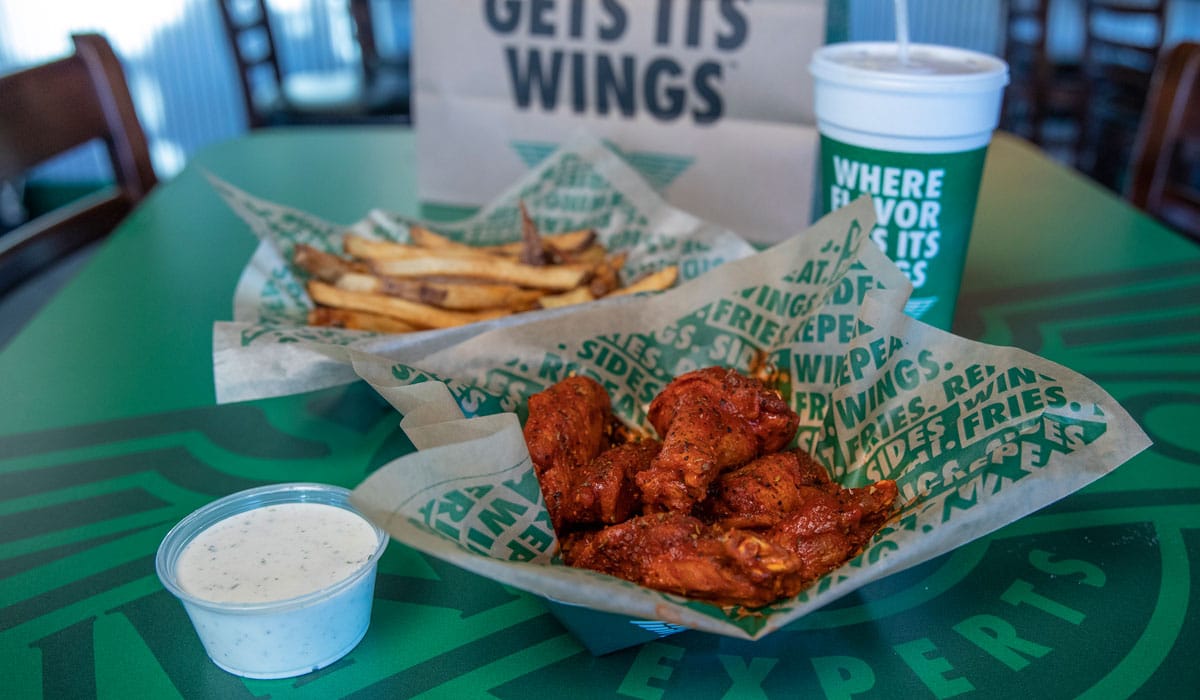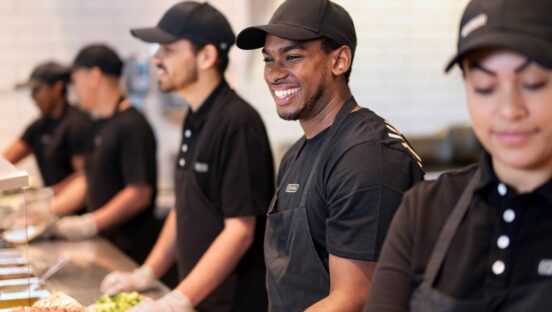Wingstop CEO Michael Skipworth began his tenure facing a turning point in the company’s COVID journey.
As the brand entered 2022, the first two months met expectations, in light of challenges with Omicron. But March proved to be a different story for a multitude of reasons: strong comps in the year-ago period driven by federal stimulus, growing demand for dine-in occasions (many of Wingstop’s dining rooms weren’t open), and sustained inflation pressuring consumers’ wallets.
U.S. same-store sales rose 1.2 percent, the chain’s lowest growth since the pandemic began. With that said, Wingstop still grew 32 percent on a three-year basis, and saw AUVs exceed $1.6 million in the quarter. But Skipworth knows the fast casual has capacity to be even better.
The belief is that Q2’s same-store sales will be flat, with April down similar to March, followed by improvement in May and June.
“Despite this volatile backdrop, we have confidence in our strategies and our ability to deliver a 19th consecutive year of same store sales growth,” Skipworth said during Wingstop’s Q1 earnings call.
His optimism starts with commodities. While most of the industry doesn’t expect prices to relent until the back half of the year, Wingstop anticipates significant deflation in bone-in wings, which Skipworth said should “more than offset” any inflation the chain may feel.
The spot market for wings reached a record $3.22 per pound last year, but now, it’s decreased to $1.64 per pound.
The company paid 14 percent more for wings in Q1 year-over-year, but that’s due to lapping lower prices in the early part of the quarter. As Wingstop exited Q1, prices “declined dramatically and continue to provide a tailwind,” said CFO Alex Kaleida. Since the chain’s peak in 2021, food costs are 800 basis points lower.
READ MORE: Wingstop’s Ambitious Growth Strategy Takes Another Leap
Even with the favorability, Skipworth said there’s still work to do with the supply chain.
“We do believe there is an opportunity for us to lean in and take more control of our supply and ultimately deliver a more predictable landed cost for our brand partners, minimizing that volatility that we’ve seen over the years, which we know if we’re able to deliver on that, it will turn this development engine into a flywheel,” he said.
The improved commodity environment gave Wingstop confidence to raise its 2022 unit growth target to more than 220 net new restaurants, exceeding last year’s record-breaking 193 net new stores. This puts the brand on pace to eclipse 2,000 units globally in 2023.
To begin the fiscal year, the fast casual opened a Q1 record 60 net new locations.
The brand finished Q1 with 1,791 stores, including 1,588 in the U.S. and 203 internationally. The long-term goal is to reach 7,000 restaurants across the world, up from the previous benchmark of 6,000.
“Cash flows for our brand partners are extremely strong right now,” Skipworth said. “And I’ve recently spent a bit of time out in market visiting with brand partners, and hearing the sentiment and the excitement about growing with Wingstop was extremely encouraging and gives us a lot of confidence in what’s in front of us and the ability to deliver a record development here in 2022.”
[image source_ID=”128572″]
The CEO also sees recently reopened dining rooms as a “highly incremental” opportunity, with the channel mixing roughly 20 percent prior to the pandemic. More than 200 restaurants kept dining rooms open throughout the quarter and outperformed the system. The average ticket for dine-in is about $4 to $5 smaller than to-go occasions.
The beauty of this move, Skipworth said, is that stores don’t need to ramp up staff ahead of opening the dining room. A Wingstop roster ranges from the mid-teens to 20, and a store can be run with as few as three people in the restaurant.
Skipworth said digital growth during the pandemic came primarily from new guest acquisition and a more affluent, heavy quick-service restaurant user. Meaning, there should be little cannibalization as stores systemwide welcome guests to dine inside.
“We saw the Omicron variant subside to some degree. It clearly demonstrated that there was some pent-up demand around dining out, and obviously, a lot of these restaurants dining rooms weren’t open for the last couple of years,” Skipworth said. “And so, it provided an opportunity for consumers to get out and dine out. And as we mentioned on the call, our dining rooms weren’t open during this time period. And so we did see that impact our trend.”
In terms of consumer spending, Wingstop saw a shift in sentiment due to Russia’s invasion of Ukraine. Skipworth said high gas prices, among other rising costs, “created an immediate and measurable impact,” particularly for those in lower-income demographics.
To resolve this issue, the CEO plans to leverage the same playbook that’s helped Wingstop achieve 18 consecutive years of same-store sales growth. And right now, it’s telling the brand to lean into value. For example, the chain recently launched a bundle that features 20 boneless wings, four flavors, fries, and two dips for just $15.99. Without TV support, the meal is driving transactions and mixing above 5 percent.
The strategy’s worked before. Skipworth recalled the Great Recession, in which the industry saw customers pull back from visiting quick-service restaurants, but were less likely to reduce their trips to Wingstop three times per quarter.
“They’ve earned that, they’ve saved their money, and they want to splurge and they want to indulge,” Skipworth said. “So, that’s really where we lean into. It’s not only just presenting them with value, but talk about the unique experience, the flavor experience at Wingstop. How it’s cooked to order. The uniqueness of our sauces. Our dips made from scratch. Our French fries hand-cut from potatoes in the restaurant every day. And so that allows us to be uniquely positioned to navigate an environment like that.”
Wingstop has the firepower to build more awareness, with a national advertising fund that’s grown from fewer than $60 million in 2019 to what should be more than $120 million in 2022. In the second quarter, the fast casual started the process of consolidating local ad spend into the national fund, a move that should deliver 40 to 50 percent more efficient advertising investments.
“The majority of [local advertising] was spent in kind of paid social, paid search advertising, maybe some radio, but I think the opportunity that we’ve described before is when we consolidate this to national and lean into our scale and buying power at the national level, we’re able to deliver the same level of advertising at $0.60 on the dollar, which creates an unlock of some meaningful efficiencies there that we can go spend and continue to drive top line drive brand awareness and improve AUVs,” Skipworth said.
Skipworth took over as CEO in mid-March after Charlie Morrison stepped down and moved to quick-service concept Salad and Go. He joined Wingstop in December 2014 and has served in a variety of leadership roles, including executive vice president and CFO and most recently as president and COO.









